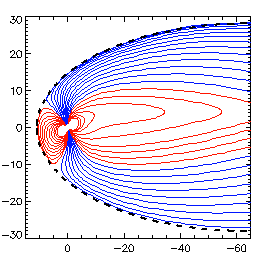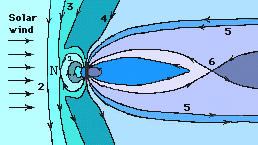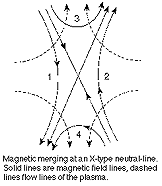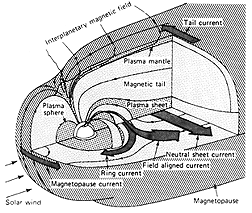Exploring Earthspace
The MagnetopauseThe two fields thus remain separated. The solar wind pushes back the Earth's field somewhat, but ultimately is forced to detour, leaving the Earth's lines enclosed in a bullet shaped cavity, which on the night side continues as a long cylinder, like the tail of a comet. The boundary surface between interplanetary field lines and those of the Earth is called the magnetopause. This lack of connection insulates the two regions from each other and makes it difficult for the particles and energy to enter the magnetosphere from the solar wind. One loophole, evident in the picture above, are the polar cusps, points on the magnetopause which separate field lines that close on the day side from those swept into the tail. At the cusps field lines seem to cross each other: that would imply a magnetic force which has more than one direction, and the only way it could happen is when the magnetic intensity drops to zero, i.e. there is no field at those points. Such neutral points are the weak spots of the magnetopause. Satellites which have probed their vicinity found disordered weak fields rather than well-defined neutral points, and a "funnel" of solar wind plasma, penetrating along field lines all the way to Earth. The cusps are a relatively minor link between the solar wind and the magnetosphere; a much more significant connection was proposed by James Dungey in 1961. Dungey noted that the Earth's field lines near the "nose" pointed northward, and suggested that when the interplanetary magnetic field (IMF) pointed southward, or had a southward slant (which grows much bigger when the lines get pressed against the boundary), the two opposing fields would cancel out and create a neutral point between them, as in the drawing below, with the point probably extended into a neutral line (a line along which the magnetic field intensity if zero) perpendicular to the drawing.
The laws by which ions and electrons are attached to magnetic field lines break down at neutral points or line, where the field goes down to zero. If the plasma flows through the neutral line, a process known as magnetic reconnection (or magnetic merging) occurs instead. Interplanetary field lines enter from one side, terrestrial ones from the other, each splits into two parts and the halves then reattach in such a way that a northern "open" line forms, half interplanetary, half terrestrial (see drawing below), and similarly on the southern side.
Dungey also suggested that such interconnections were temporary, and that after the particles threading a pair of "open" lines moved further downstream, the process was reversed at another neutral line, somewhere in the far tail. Because open lines extend from the solar wind to Earth, they can effectively transmit plasma and energy from one to the other. Evidence for this appeared in 1966, when it was found that the degree of magnetic "storminess" tended to be much increased whenever the IMF had a southward slant.
Processes at the Magnetopause
Because of the high speed of the solar wind, a bow shock is formed about 3-4 RE outside the nose, like the shock front ahead of a supersonic aircraft. The solar wind just behind the shock (a region called the magnetosheath) is slower, denser and hotter, but as it flows downstream it gradually recovers its normal properties. Satellites which cross the magnetopause into the solar wind often see an abrupt transition, as Explorer 12 did when the boundary was discovered in 1961. The magnetic field becomes weaker and its direction may drastically shift, while the plasma becomes denser and flows rapidly along the boundary, away from the Sun. Sometimes a boundary layer is encountered between the two regions, a transition region across which the field and plasma properties gradually change. The inner magnetosphere contains the radiation belts and the ring current, already discussed. It extends approximately to synchronous orbit, sometimes further, and compared to other regions it is rather stable.
The Earth's Magnetic TailThe largest features of the tail are two oppositely directed bundles of stretched field lines, nearly parallel, extending from Earth to great distances. Field lines of the northern "tail lobe" connect to the vicinity of the northern magnetic pole, and are directed towards the earth, while those in the southern lobe are connected near the southern pole and are directed away. Sandwiched between them is the denser plasma sheet. To produce these deformations of the Earth's nighside field, additional electric currents are required. It turns out that those currents--quite large ones--flow across the width of the plasma sheet, from edge to edge (see preceding drawing). Once the current reaches the magnetopause, it divides into 2 parts which close around the lobes, over the top and under the bottom of the tail. Of all the parts of the magnetosphere the plasma sheet is the most dynamic. If one traces its field lines back to Earth, one finds that they land in the "ring of fire" around the pole which is lit up by the aurora, the "auroral oval." Hence the widespread belief that the aurora comes from the plasma sheet, although some might be linked more directly to the solar wind. James Dungey proposed in 1961 that the Earth's lines could link up with the IMF, producing "open" lines (field lines with one end connected to Earth and the other to the IMF), which are then carried tailward by the solar wind. He also suggested that those lines and their attached plasma (at least in their near-earth parts) sooner or later return to their starting positions, creating a closed cycle. His view was that somewhere in the far tail, northern and southern lines reconnected again, and that the plasma on the reconstituted terrestrial lines then flowed back inside the plasma sheet. Such a process would predict that satellites observing the plasma sheet would always observe its particles flowing towards the Earth. Earthward flows are indeed observed there; but the picture is not so simple, because the flows are rather irregular and seem to occur mainly in substorms, described in a later section.
Monitoring the Solar WindThe IMP 8 satellite (Interplanetary Monitoring Platform 8) has been on the job for more than 20 years, sweeping around Earth in a big circle, with a radius of about 35 RE. It continues to provide extensive information about the wind, bow shock, and even about the tail, which its orbit also crosses. To provide an early warning about the solar wind, however, the best place for a spacecraft is between the Sun and the Earth. Luckily, the gravitational pulls of the two bodies allow a spacecraft to maintain a fixed position between them, at the "Lagrangian point" L1 located 236 RE upstream of the Earth, about 4 times the distance to the Moon. A spacecraft at L1 intercepts the solar wind approximately one hour before it hits Earth and thus can give us a one-hour warning of impending changes. In 1978 the ISEE-3 spacecraft (International Sun-Earth Explorer 3) was sent to the vicinity of L1, where for a few years it monitored the solar wind, after which it was detailed to explore the far tail; still later it was sent to encounter a comet. Currently (1997) the SOHO spacecraft (Solar ... Observatory) is in such an orbit and observes the solar wind before it reaches Earth, and the Ace spacecraft (Advanced Composition Explorer) is due to join it there. The "Wind" spacecraft, originally scheduled for such an orbit, is still observing the solar wind from its very elongated transfer orbit. Since it has its own propulsion and a large reserve of fuel, it might be diverted to an alternate mission. Connect to IMP-8 Project Homepage.
|
 Dungey's reconnection picture
Dungey's reconnection picture Cartoon of two lines, before, during and after reconnection
Cartoon of two lines, before, during and after reconnection More about the magnetopause and reconnection
More about the magnetopause and reconnection
 More about the structure
More about the structure More about the Earth's magnetic tail
More about the Earth's magnetic tail More about Lagrangian points
More about Lagrangian points More on the Wind spacecraft
More on the Wind spacecraft